Padmini is Mohanambal, a beautiful and exceptionally talented bharatanatyam dancer. Sivaji Ganesan is the less beautiful but equally talented musician, nadaswaram player Sikkal Shanmughan. Crossing paths at a temple festival sparks fly between them but within minutes they go from this:
To this:
They challenge each other to a contest of dance versus music at some later date. So the stage is set for a fiery romance, riddled with misunderstanding, thwarted by pride and a meddling mother (Vadivambal, played by C.K. Saraswathi).
Mohana believes that dance is for everyone and for all occasions, inspired by the world around the dancer as well as a gift of god. Sikkal is more of a princess, demanding that his audience give him full attention and due reverence as he displays his gift. He believes art exists for god and for the artist. He refuses Mohana’s invitation to stay and watch her dance, but sneaks back later to see this.
There are some interesting observations on women in the performing arts and Mohana is certainly subject to some assumptions by men who desire her beauty and talent. Her mother seeks to ensure a wealthy man as her daughter’s protector or husband, but Mohana rejects all offers even before her feelings for Shanmughan are an issue. Nagalingam (K Balaji) is one thwarted suitor and a kidnapping attempt results in a comedy fight scene that I could have done without. I don’t quite get the undersized guy with stupid hair as instant hilarity, and there are two of them (double the fun?). This diversion means Mohana and her group catch the same train as Sikkal who has been waiting in the hopes they might turn up.
Padmini is gorgeous and her dance training is evident in her deportment and expressions as she uses all of her skill in conveying Mohana’s emotions. She also does an exceptionally good eyelash flutter. Sivaji is more old school theatrical, and lays it on almost as thick as his makeup. But his somewhat rubbery face is wonderfully expressive, especially his eyes, and he does have palpable chemistry with Padmini. There is a delightful scene of wordless communication and voiceover on the train journey that is funny, romantic and beautiful.
There is lots of sparring between the two and she is not the heroine to fall in love and lose her sense of self. I liked seeing a young lady who was a bit of a brat, very self-confident, and who felt no need to be apologetic. I don’t think I would enjoy her half as much in real life, but she did keep my attention in the film. And there was no suggestion that she should give up dancing to be a servant of Sikkal’s muse. She was a dancer and was valued for her gift.
There are abundant comedy elements. Manorama is Jil Jil Ramamani, a folk dancer and girl of suspect virtue. Her ‘comic’ dances are strange, and perhaps the subtitle team decided to make sure we knew this was a modern film:
In addition to being the butt of many jokes, she does play a significant role at several points in the story. Manorama made her character both a caricature and quite sympathetic. I was left thinking Jil Jil understood herself and how others saw her, and she retained some dignity despite the silliness. Nagesh as Vaithy had a role that just irritated me. He is a Jerry Lewis kind of character, so if you like the style, you may have warmer feelings towards him than I do.
His presence extends the story with pranks and frauds, and a longwinded and obtuse approach to being a go-between. The supporting characters are pretty broadly drawn and usually played for comedic effect or buffoonery. There is some excellent face throughout.
There are pointed references to the issues of art versus money, the dedication of great artists and who owns art. Sikkal storms out of a private party rather than be ‘owned’ by the landlord and plays an impromptu concert to the locals gathered outside. I particularly enjoy this face off where the classical versus modern question is settled judging by the smug expression on Sivaji’s face (wait for the white couple to turn up at about 4 min):
Mohana is pursued with increasing vigour by the landlord and the ensuing scenes are quite farcical. I was quite annoyed that Sikkal immediately assumed Mohana was playing him, without speaking to her or investigating. He just did the heroic leap to the conclusion that she was duplicitous and decided to feel sorry for himself. I might have been more tolerant of manly brooding in a more attractive character, but really I just wanted to slap him. He then departs to sulk with Jil Jil, now calling herself Rosarani, who owns a drama company. Word of this gets back to Mohana who knows about his misunderstanding but had hoped he might still be interested. Rather than giving up, judging or moping, she decides to confront him.
Jil Jil and Mohana show themselves to be more decisive and action oriented than many a filmi heroine. I have doubts over the subtitle translation of some of the relationships as people refer to the landlord wanting Mohana to live with him, but he is also referred to as a groom, there is mention of dowry and so on and he has a wife already. In one scene, Padmini begs him not to spoil both their lives and mentions women being enslaved by money. So I am guessing she would have been his mistress but perhaps the subtitle team decided to sanitise the arrangements. Regardless, her modesty and chastity helps to persuade the landlord to be a brother rather than a suitor.
Mohana knew that the only way to keep Sikkal from leaving India with Jil Jil was to appeal to his artistic pride. The Thillana contest goes ahead. Nagalingam returns for skulduggery resulting in Sikkal taking a knife to the arm. Sivaji really milks the scene, thrashing around like a fish out of water for what seems like minutes. This injury prompts a further outbreak of overacting, and Sikkal gets another opportunity to feel sorry for himself again. Thanks to yet another smart competent woman (his nurse Mary) he begins to see that perhaps he has been a little narrow minded.
The finale is predictable but unravels over yet another complex scheme to sell Mohana, this time to a King. She defends herself, verbally and physically, and finds an ally in the very peculiarly accented Queen. Her chastity proves transformative once again, and the King decides to be a good husband.
Sikkal jumps to conclusions (yes, again!) and flings himself around chewing the scenery. This time Mohana has had enough and decides to resolve things. The climax is very filmi and over the top but the duelling diva personalities of the leads made it less unbelievable than it might have been.
This is such a pretty film. The ladies wear beautiful jewellery and costumes, there are lots of sparkly things, the temple locations and houses are lovely. It also has quite a timeless feel, with only a couple of scenes overtly placing the story in the late 1960s. The story is an overblown romantic melodrama but the theme of art and excellence gives the characters much more substance than I expected. The female characters stand on their own feet, and have their own plans and desires. Padmini and Sivaji are exceptional and really made me care about their relationship even as their characters annoyed me sometimes. And of course, Padmini’s dancing alone makes this worth a look. Who won the contest you ask? Art was the winner! 4 stars.
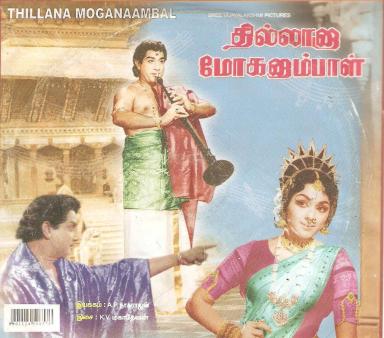
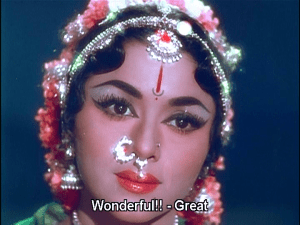
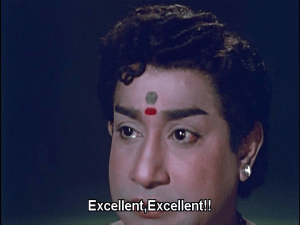

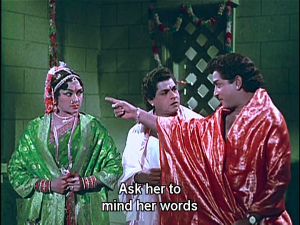






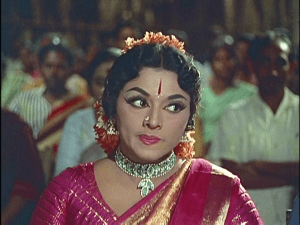




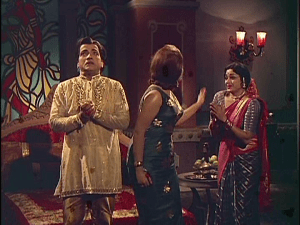
Umm … wait … trains? white people? kings? Nurse Mary? Just what time frame is this film set in? Somehow I was always under the impression that it was a historical, especially given Mohanambal’s character, and the setting for her dances in temples.
This is one of those movies about which I’ve heard so much, and seen so many clips, that I almost feel like I’ve seen it — except that I haven’t. Now, the seeming anachronisms mentioned above are encouraging to watch it ASAP.
LikeLike
Hi mm. Judging by the outfits on the white people and Queen Ashalatha (she of the peculiar accent) I guess it’s set in the late 1960s. There is no real sense of this being set in a specific time so I was slightly surprised when a bunch of girls in one-design-suits-all party frocks turned up and started doing the twist while the groovy band played on 🙂 Temple
LikeLike
See, this is only increasing my sense of WTH’ery (sorry, I don’t use that other word 🙂 ). As a story between a temple dancer and a court musician the whole thing made sense. As a story set in the era of trains, twist, and western music in India, it makes no sense. This is because the perils of Mohanambal as you’ve outlined them above is self-contradictory. There used to be a particular “community” where the women were only kept as mistresses, and never officially married to anyone, and many of them were proficient in music and dance. But guess what, there was a social reform movement to abolish that practice, that started in the 1930’s, and by 1960, it was completely removed. This is not to say that mistresses and dancers didn’t continue, and sometimes a woman could be both, but that the practice of a mother trying to arrange a protector for her daughter in this community was, if not completely nonexistent, completely socially unacceptable. So I’m having a hard time understanding where this story is coming from. As I said, I’ll just have to watch it and figure it out.
LikeLike
Having said the above, I must add that I can remember films (and novels, too) produced in the 1960’s and 1970’s, which featured a character from this community. But there the story’s focus was on the prejudices she would encounter in breaking out of the practices of the past.
I was intrigued that you said one of Sivaji’s character’s complaints was about the increasing influence of western music. A similar theme was there in the Telugu movie Sankarabharanam, and the question of what the artist owes society via his art was central to the Chiranjeevi movie Rudraveena. And of course there was that whole slew of artist based films by K. Viswanath in the 1970’s and 1980’s (the artists in question were singers, dancers, musicians, painters, etc.) Maybe it was some burning question of the day in Madras (now Chennai) of that time that I’m just not aware of. It makes me intrigued as to what prompted it.
LikeLike
I believe this was based on a novel so maybe there is an appropriate F word to use here – fiction 🙂 It didn’t seem any more far-fetched or incongruous than many other filmi plot devices so I didn’t find the anachronisms detracted from the melodramatic proceedings. There was no reference that I can recall to Mohana wanting to break free of her community’s traditions, just the day to day conflict with her domineering mother. There is a voiceover during the opening titles which introduced this as a social film so maybe this was tied to issues in the performing arts sector back in the day? Let me know what you think once you watch it? Temple
LikeLike
Rap in 1968? WHO KNEW! And perhaps another clear winner of any contest is the eyebrow technician?
I do like a film that discusses female artists. Intrigued!
LikeLike
Hi Beth 🙂 There is also a disco dancer! In ‘traditional’ village belle bling, no less. The certificate for the film did state it was a recertification in 1978 so maybe they decided to update the subs? The subtitle team work in mysterious ways.
LikeLike
I haven’t watched any Tamil oldies yet, and this one looks like an good candidate, with the crazy beautiful colors. Nice work with the screencaps.
LikeLike
Hi Liz. I haven’t watched many pre 70s/80s Tamil films apart from a couple of mythologicals so I’m not much use with recommendations, but I did really enjoy Padmini and Sivaji in this. And of course, you’re right about the colours being just beautiful. Its a very pleasing film to look at.
LikeLike
This is slightly off topic, but, since this is the review of a “classic” Tamil film, not so much. In any case, for those who want to know more about Tamil cinema, especially its noteworthy films of the past, this article (and some of the comments) will be useful: http://www.rediff.com/movies/slide-show/slide-show-1-south-ten-pathbreaking-films-by-k-balachander/20110502.htm
LikeLike
thanks! I’ve made more notes on the never-ending list.
LikeLike
Hi, my sister and I are looking for a movie that honestly we don’t know the name of but we can tell you parts of the story line. We think its a malayalam film from the 60s it had a story about a guy who falls in love with a princess only to realize he will never get her as a poor guy, he then is sent to jail because he tries to talk to her and he meets an old man who tells him of a wizard or sorcerer that was punished and stuck in a cave for evil but if you realised him he would grant you wishes, they do that and in this story line they meet a gigantic large bird, and there is a dance number with an item girl who turns into a gorilla. I know this sounds incredibily weird but we were kids when we watched this movie and fell in love we can’t seem to find it at all. If anyone knows anything about this movie we would appreciate it…
LikeLike
Hi Shalini
That sounds fantastic! I’ll certainly ask around as there are far more knowledgeable film fans out there than me. It does sound slightly simlar to Patala Bhairavi (I’ve written about it on this blog) – the poor gardener falls for a princess and falls into the clutches of an evil wizard who has a cave lair. But the wishes are granted by the goddess of the underworld and the item girl starts out as a monkey and becomes a girl!
Do you recall if it was colour or B&W?
I will see what I can find. Do let me know if you track it down too – I want to see it!
Cheers
Temple
LikeLike
Hi Shalini
I have been told by a lovely Twitter friend this is probably a Hindi film from the 90s (that looks like it was made in the 70s) – Haatim Tai, starring Jeetendra. The storyline matches and there is a scene with an item girl turning into a gorilla. Let me know if that’s it? Either way, I plan on watching it soon.
Cheers
Temple
LikeLike
Hello! It was interesting to read a review of a film which I have known since childhood through the eyes of an ‘outsider’, if I may be excused for saying so 🙂 This film is considered a classic and when I had recently commented that it had ‘aged’ in my eyes, a number of my fellow Tamil friends protested. Its like criticizing Ben Hur or something…perhaps there are flaws (for sure there are flaws!) but the film occupies a ‘can’t be touched’ status amongst us Tamils. You mention Sivaji Ganesan’s overly theatrical style – again, you won’t find many locals supporting you, Sivaji was (is) much loved. His style works great in historicals of course but even otherwise..his diction, his mastery over the language..ah! His characters are a overblown and not so real, we all know it, but that doesn’t mean it can’t be admired. Do we not admire Picasso’s cubic women or Monet’s fragmented colours even if they are so – can I say theatrical? And as to Sivaji’s looks, in his days he had his own female followers who found him very attractive, I assure you! (But I am with you here 🙂 I too found myself very annoyed with Sivaji’s character for jumping to conclusions about Padmini and behaving in such a MCP way…but that probably reflects the mode of thinking in those days. I enjoyed reading you, I’ll be back!
LikeLike
Hi Suja! You may absolutely call me an outsider when it comes to Indian cinema 🙂 I’m always aware with a classic that people who have known and loved it have a whole raft of associations and emotions tied up with the film where I may not. I am happy to criticise Ben Hur, but maybe that’s because I was forced to watch it so many times in my childhood 🙂 This is my first Sivaji film, apart from some clips on youtube, so I will seek out more and maybe look for an historical next – any recommendations? Thanks! Temple
LikeLike
Well, you can always look for “Sivaji” the film which gave its name to “Sivaji” Ganesan. 🙂 His great film that I have always seen quoted is “Veera Pandya Katta Brahman”, which is also a historical.
Suja, I have often seen this “criticism”, if you will, that Sivaji Ganesan’s acting is theatrical. It is not surprising that it should be so, since he not only came from a theatrical background, but continued to act on stage simultaneously while acting in films, and running a very successful theatrical company in Madras (Chennai). However, I wonder if it really was theatrical all the time. I haven’t seen a whole lot of his films (in fact, hardly any, though I know him by reputation), but I did see one in the early 1970’s which had him playing a village yokel, and I certainly didn’t feel that his acting was particularly “theatrical” or “unnatural.” But then, the standards and audience expectations of those days were completely different. I think when people say “theatrical”, though, they really mean “stylistic”, which is a certain school of acting. For example, Lawrence Olivier’s acting could also be called “stylistic”, “overly mannered”, or “theatrical” by today’s Hollywoodized standards, but does that take away from his skill? As you say, Sivaji Ganesan was famous for his dialogue delivery. In fact, perhaps because of his influence, Tamil films of those days were known for their “theatrical” dialogs, at least among Telugu film goers. 🙂
I was reading an autobiography of Sivaji Ganesan a couple of years ago, and was very surprised to discover that he went on the stage at a very early age, in fact, young enough to be playing girls! Of course the boys could only keep this up until their voices broke in puberty. But one comment of his that I found very interesting was that he deliberately stopped playing girl parts, or exclusively girl parts, even while he could still convincingly play them, because he did not want to develop a “feminine” body language that would be hard to shake later. I found this interesting because I had never thought of him as being “feminized” in any way, while his counterpart in Telugu films (at least in terms of stardom) was A. Nageswara Rao, who also started on the stage at a young age, playing girl parts. But, unlike Ganesan, I always felt that a little “femininity” clung to him even as he became a revered hero. Or perhaps it was only because of the contrast with the other luminary of the Telugu screen, N. T. Rama Rao, who came across in a very masculine way (except when he was playing “woman”, or rather eunuch, Brihannala, in “Nartana Shala”). Sivaji Ganesan always seemed comparable to NTR for me in terms of screen presence.
All right, I’ll stop rambling now.
LikeLike
mm I think you, me and Suja are on the same page in terms of how we define theatrical or stagey acting. It’s certainly very common in Hollywood and British films through until the 60s/70s as the training path was stage to screen for the most part. It’s not a style I dislike but it is noticeable when compared to the made-for-camera performances of today and so was quite striking. I have seen a few vintage ANR and NTR films (and I will be writing about Nartana Shala in a few weeks) and I do find the acting dated, but certainly not unwatchable. I think that style weathers the ages better in historical and mythological themes which are also highly stylised. With reference to Sivaji in this (not quite historical) film, there are some really effective low key scenes – Suja may recall the confrontation with Padmini in the palace just before the climax of the film, the train scene I mentioned – but there are a couple of really over the top moments too and that’s where I pictured him declaiming from a stage. So mm I encourage you to watch this and come back with more thoughts 🙂 And don’t stop rambling! Thanks for the film recommendations too. I’ve tracked down a subtitled copy of Shankarabharanam which is on it’s way!
And Suja – I had a quick look at your blog today and will be back to read more of your music reviews 🙂
Temple
LikeLike
@Temple : This is an interesting discussion 🙂 Even in the 60s, there were Tamil films produced with lots of theatricals and others with next to none. I remember especially the comedies of Cho, which I loved, which were very current. I am not sure Temple whether you know that there are different Tamils – the way it is written now is not the way it is spoken, the way it was written & spoken in history was way different (I guess if Shakespeare’s language changed so much in 500 or so years, the same thing has happened everywhere). The funny thing in Tamil is that the old language is still understood because much of the poetry & music from olden times (for example Andal’s Tiruppavai – poetry – from the 8th century) is still sung often in many households. (my mother for example and my grandmother recited these). I have heard speeches in which a colloquial Tamil would be used and suddenly they would switch to classical Tamil and go on!! Written Tamil has changed somewhat but is somewhere between classical and colloquial. Its all very confusing! Now what was I saying all that for…sorry, I too have a rambling disease…well, Sivaji Ganesan does this old world Tamil beautifully and you know, when one is theeing & thouing, one has to do it in style, no? 🙂 I dont watch many Tamil films so I hesitate to give recommendations. For what uts worth – A classic from the same era as Thillana Mohanambal is Thiruvilayadal, not a historical but mythological (basically devotional). Will it make any sense to someone not imbued in Hinduistic lore? I dont know. Thiruvarutselvar from 1967 is of the same ilk.( I love these films but in an illogical way, critical hat is chucked into the attic while watching 🙂 One of the stories in this one is about the aforementioned Andal. Raja Raja Chozhan (spelling?) was a historical, about the most important Chola dynasty king but as I havent watched it since my childhood, I dont know what I am recommending! MM’s recommendation is a good one (Veerapandiya Kattabomman – note spelling). Hope you have better informed readers than I 🙂 A couple of his well appreciated socials were Mudhal Mariyadai & Thevar Magan, both done in a more mature age.
BTW Thanks for visiting my blog 🙂
LikeLike
Thanks for explaining the complexity of the Tamil language. I always tend to assume that older films use more formal grammar, less slang, fewer abbreviations, less English vocabulary – but the way language changes over time and with different usage is fascinating, and Tamil sounds even more complex than I suspected! I do agree, if you’re going to Thee and Thou , the delivery requires panache 🙂 I am finding it a little amusing that the use of the word ‘theatrical’ has drawn such a response 😀
Finding older Tamil and Telugu films with subtitles is a challenge, and I have added all these lovely suggestions to my list. It’s a long list and I show no sign of getting anywhere near the end of it.
I will jump in and recommend Mayabazar if you haven’t already seen it. It’s a classic Telugu mythological (sort of – well, based on a popular play I believe) and with the cast including ANR, NTR, SV Ranga Rao and Savitri it is just a delight. I have the colourised version of the film, and it is very well done and looks stunning. The songs are beautiful 🙂 Nartana Shala is also lovely and has L Vijayalakshmi as NTR’s dance student. I enjoyed Darna Veera Suura Karna too, although I had to really concentrate to keep all the NTR multiple roles straight. But I will defer to mm’s much more extensive knowledge as I am a total rookie. Cheers! Temple
LikeLike
@MM : Your comments are very interesting, I didn’t know he had done female roles in his youth! His looks are not suitable surely? Now NTR was a beautiful man (I remember his playing Krishna in some Tamil films, he had such a good looking face that I still remember it after all these years!). I can imagine him fitting into a female role in his early youth..
Of late, I have been very interested in mythologicals & historicals. You have mentioned Natana Shala, I will try and find a copy the next time I am in India. Can you give me recommendations for the best Telugu historicals & mythological films? I saw the relatively recent Annamayya with subtitles but I rather objected to them trying to cater to mass audience and fitting in some romance at the start. I wanted to watch Tyagayya but couldnt find a subtitled copy online. I have seen and loved Shankarabharanam when it came out originally, I saw the Tamil dubbed version. I’ll be very happy if you can give me some recommendations. Thank you 🙂
LikeLike
Hey,
Find it really strange that you actually watched this iconic “old” tamil film. Sivaji was one of the brightest stars in the industry at that time when Tamil cinema was strongly influenced by theatre (can also be called overacting 🙂 ) and politics.
As suggested above, I also recommend “Thiruvilayadal”; an epic where he plays Lord Shiva. This song from the film is one of the all time classics of tamil cinema:
LikeLike
Thanks Ajit! I watched this on the recommendation of a friend (she’s Australian, doesn’t speak Tamil) and I’m so glad she suggested it. We both enjoy a lot of older films, and I always like a film with great dancing. Since I can’t dance to save my life, I love to see people who can. Your added recommendation of “Thiruvilayadal” is duly noted 🙂 Temple
LikeLike
Well, the film is on youtube with eng subs 🙂 uploaded by the production company who own it! LOL
http://www.youtube.com/watch?v=zztzKqHb66c (rajshritamil)
Since we are on the topic of old films, I also recommend films by Padmarajan, the great man who revolutionalized Malayalam cinema in the 80’s.
His film “Thoovanathumbikal” and “Namukku paarkan mundhiri thooppukal” (among others) still ranks as some of the finest among the mallu public, which depicted a generation.
http://en.wikipedia.org/wiki/P._Padmarajan
http://en.wikipedia.org/wiki/Thoovanathumbikal
http://en.wikipedia.org/wiki/Namukku_Parkkan_Munthiri_Thoppukal
Thanks for the reply 🙂
LikeLike
Thanks again Ajit 🙂 The links are much appreciated. I love that Rajshri Tamil almost force you to watch their films for nothing and others do all in their power to make even buying a DVD an adventure. Cheers, Temple
LikeLike
The film is set around 1930-1940
Trains were there with all the classes and the routes mentioned here. (TJ-TVR primarily even NGT)
Cars were there
Bullock carts were there
Few remaining kings were there though they were ruling under the auspices of the british empire
a king looking at a dance girl and wanting her is not uncommon and so in the landlord wanting.
There were tent drama troupes at that time.
There were ultra elite who were in British service that can wear frock and do twist dances.
Mostly the timeline works and not a lot of abatham in the period setting.
LikeLike
Hi Siva. Thanks – I think the timeline works perfectly well, but I had no expectation the film was historical. Based on the western clothes and music, and the Twist, the story looks like it is set in the late 1950s to early 60s, not any earlier – so maybe that’s the only anachronism. The thing that really makes this such a standout are the two fantastic leads and their characters. Cheers, Temple
LikeLike
It would be great if you could review great movies like Ulagum Sutrum Valiban, Anbee Vaa, Ragasiya Police 115, En Kadamai, Thayai Katha Thanayan, Idhayakani, Nadodi, Engal Thangam and the 28 superhits MGR had opposite both Saroja Devi and Jayalaithaa each plus Nagesh Classics like Anubhavi Raja Anubhavi, Thenmazhai with Cho.
I feel you can do justice to them, so felt sharing with you the movies which you should promote thru your blog.
LikeLike
Hi Shrikant. Thanks for all your recommendations, and your confidence that I could do justice to them 🙂 I have some of these on my list already but the problem is finding a DVD. So many older films are very hard to get on DVD or VCD, and finding them with subtitles is even harder. It does limit my viewing a little as older films tended to have more complex dialogue so subs really do help. I’ve been looking for a copy of Navarathri with Sivaji Ganesan and Savitri for ages but so far I can only find the Telugu remake with ANR and Savitri. Temple
LikeLike
Pingback: Louis Malle on the set of Thillana Mohanambal : the unreachable otherness. – 1916
Hi ! Your post is one of the references of my article on “Louis Malle on Thillana Mohanambal set”. Thanks for this good piece of writing. Do take a look at the article and the blog, it might interest you : https://1916tamilcinema.wordpress.com/
LikeLike